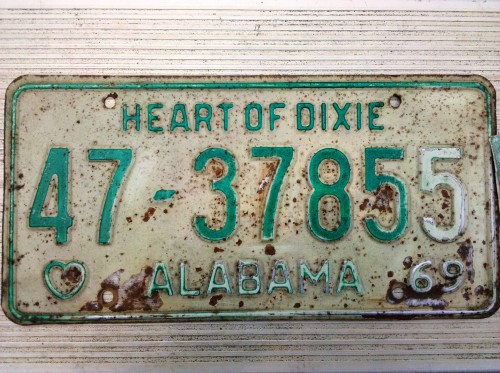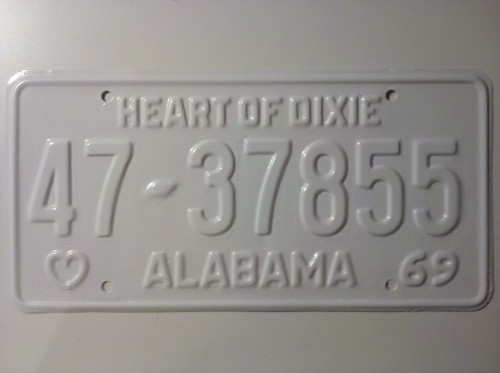Tech article by Jacob Schreiber (Schreiber)
Although ClassicBroncos.com covers almost every Bronco project imaginable, one I’ve never seen is a write-up on restoring original license plates. This is an easy project. I took some pictures while refinishing mine, so why not share?
I found my tag at a local antique shop for $10. I was also fortunate find one with the correct county prefix numbers. Ebay is another good resource when shopping for old tags.
When I bought my tag, I didn’t realize I could potentially register it to use with my Bronco. It was only after reading about purchasing a new ‘antique vehicle’ tag that I realized this was a possibility.
The most tedious work is not the sanding or painting, but researching your state’s laws regarding using original plates. In Alabama, for example, one can register early license plates as long as the year on the tag corresponds with the year of the vehicle. The only other requirement is that the tag must be in very good shape and readable. In this case, I knew my tag would need to be refinished.
The first step was sanding. Because these license plates are old and made of relatively thin metal, I decided to hand sand mine. I made sure to hit the rust spots first, and then moved on to removing the old paint.

The paint came off easily enough using eighty grit sandpaper. I didn’t worry about removing every bit of paint, just cleaning up the obviously ugly parts. While reading about similar projects on the web I heard that paint stripper might work also. I didn’t try this method.

After working on the rust and old paint, I got down to mostly metal surface. I was happy with how well much this shined. I also took time to straighten out the plate. There were small dents and curves where the tag should have been straight. I was able to straighten out the old tag by hand.

I sprayed my first coat with a Rustoleum grey primer. I was amazed at the difference this made. I sprayed front and back, and allowed the tag to dry per the directions on the rattle can.

My next coat was again Rustoleum. This time I used a white semi-gloss. I allowed this coat to dry. Next, I sanded with very fine 220 grit sandpaper. I sprayed a second coat of white semi-gloss front and back and allowed it to dry.

Finally I was ready to paint the numbers and letters. I painted with a model paint found at my local craft store. This model paint worked well mainly because there was a large selection of colors to choose from and it was dirt cheap. I painted by hand with a detailing paint brush with a tiny tip. It didn’t take long to paint, and I’m sure the results would be better one took their time to make it flawless. I did mine quickly (and a little sloppy).

The tag turned out well. Like my Bronco’s paint, it looks better from ten or fifteen feet away. This tag adds an extra bit of originality. Even better, I can keep using this tag year after year and don’t have to switch to a different tag.

The folks at my motor vehicle department took a minute to figure out how to register the tag to me, but once they figured it out, it was as easy as sticking a little decal with the current year on the tag; just like you would do with a normal tag.
Check with your state’s motor vehicle division to ensure you can register and use your old tag as a legitimate tag. Alabama has interesting references where one can learn more about old tags: http://www.revenue.alabama.gov/motorvehicle/vintagepassengertags.html
Although ClassicBroncos.com covers almost every Bronco project imaginable, one I’ve never seen is a write-up on restoring original license plates. This is an easy project. I took some pictures while refinishing mine, so why not share?
I found my tag at a local antique shop for $10. I was also fortunate find one with the correct county prefix numbers. Ebay is another good resource when shopping for old tags.
When I bought my tag, I didn’t realize I could potentially register it to use with my Bronco. It was only after reading about purchasing a new ‘antique vehicle’ tag that I realized this was a possibility.
The most tedious work is not the sanding or painting, but researching your state’s laws regarding using original plates. In Alabama, for example, one can register early license plates as long as the year on the tag corresponds with the year of the vehicle. The only other requirement is that the tag must be in very good shape and readable. In this case, I knew my tag would need to be refinished.
The first step was sanding. Because these license plates are old and made of relatively thin metal, I decided to hand sand mine. I made sure to hit the rust spots first, and then moved on to removing the old paint.

The paint came off easily enough using eighty grit sandpaper. I didn’t worry about removing every bit of paint, just cleaning up the obviously ugly parts. While reading about similar projects on the web I heard that paint stripper might work also. I didn’t try this method.

After working on the rust and old paint, I got down to mostly metal surface. I was happy with how well much this shined. I also took time to straighten out the plate. There were small dents and curves where the tag should have been straight. I was able to straighten out the old tag by hand.

I sprayed my first coat with a Rustoleum grey primer. I was amazed at the difference this made. I sprayed front and back, and allowed the tag to dry per the directions on the rattle can.

My next coat was again Rustoleum. This time I used a white semi-gloss. I allowed this coat to dry. Next, I sanded with very fine 220 grit sandpaper. I sprayed a second coat of white semi-gloss front and back and allowed it to dry.

Finally I was ready to paint the numbers and letters. I painted with a model paint found at my local craft store. This model paint worked well mainly because there was a large selection of colors to choose from and it was dirt cheap. I painted by hand with a detailing paint brush with a tiny tip. It didn’t take long to paint, and I’m sure the results would be better one took their time to make it flawless. I did mine quickly (and a little sloppy).

The tag turned out well. Like my Bronco’s paint, it looks better from ten or fifteen feet away. This tag adds an extra bit of originality. Even better, I can keep using this tag year after year and don’t have to switch to a different tag.

The folks at my motor vehicle department took a minute to figure out how to register the tag to me, but once they figured it out, it was as easy as sticking a little decal with the current year on the tag; just like you would do with a normal tag.
Check with your state’s motor vehicle division to ensure you can register and use your old tag as a legitimate tag. Alabama has interesting references where one can learn more about old tags: http://www.revenue.alabama.gov/motorvehicle/vintagepassengertags.html










